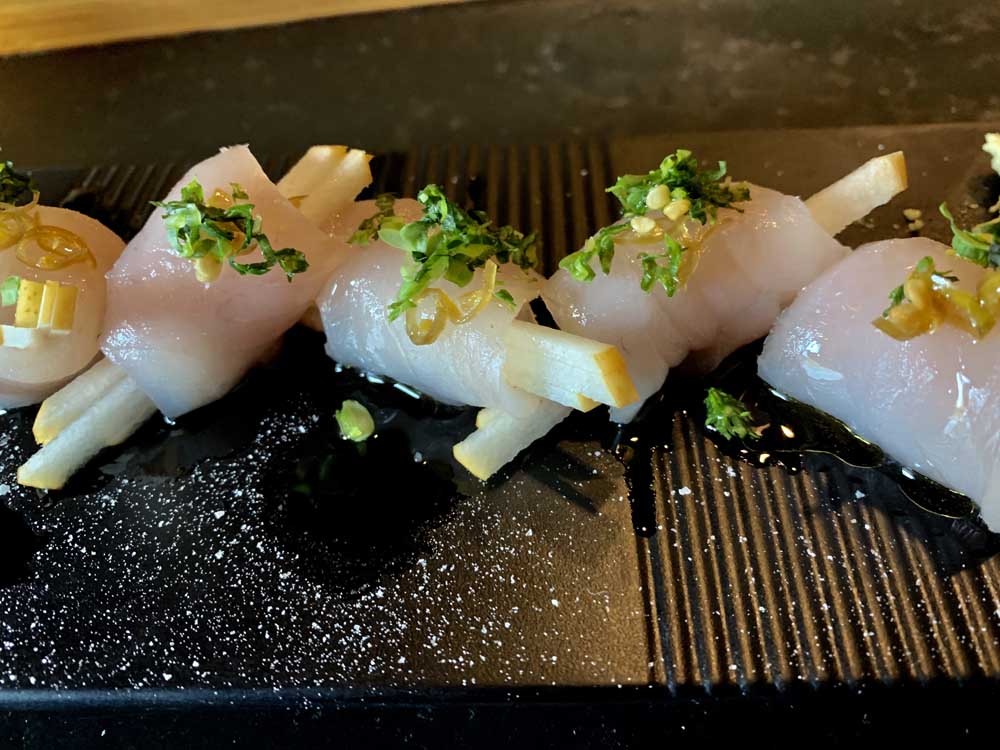Restaurant review: Kanpai Sushi & Cocktails
Published 12:00 am Thursday, August 1, 2019

- Hawaiian ono is wrapped around spears of sweet Asian pear and finished with Thai chilies. (Barb Gonzalez / For The Bulletin)
Directly translated from the Japanese, the word omakase (pronounced oh-mah-KAH-see) means “I’ll leave it up to you.”
In a good Japanese restaurant, ordering omakase isn’t an excuse for being uncertain what to order. Instead, it offers the chef an opportunity to show off what he or she can do with fresh ingredients and a creative drive.
Justin Cook, the executive chef and owner at Kanpai Sushi & Cocktails on NW Newport Avenue in Bend, encourages diners to consider the omakase option. My dining companion and I did so on a recent visit, and by the time our meal was finished, we had come to the conclusion that Kanpai isn’t just a good Japanese restaurant. It is one of the best restaurants in Bend of any type.
As designed by the uncannily named Cook, whose surname aptly foreshadowed his chosen career, an omakase at Kanpai becomes a personal chef experience. Our gourmet eight-course meal was proof positive that a dinner in a sushi bar doesn’t even have to include sushi — or rice, for that matter.
It did, however, include pairings with sake (pronounced SAH-kay), the brewed Japanese rice wine of which this restaurant has a prodigious selection. Indeed, the word kanpai (pronounced kahn-PIE) is Japanese for “Cheers!”
Starting out
The seafood at Kanpai would be nowhere near as good were it not fresh — delivered three or four times a week from four purveyors, on the U.S. mainland and in Hawaii. Nothing sits in the cooler at this restaurant for longer than 48 hours.
Our meal began with a half-dozen bites of ono, a delicate tropical fish also known as wahoo. Touched with olive oil and ponzu (soy-citrus) sauce, seasoned with herbs and sea salt, the ono was wrapped around spears of sweet Asian pear and finished with pickled, minced Thai chilies that gave it a tongue-tingling bite.
Second course consisted of four oysters, raw and on the half shell. Cook called this his homage to the bounty of Washington state. A pair of thumbnail-sized Kumamoto oysters were served in a vinaigrette of cherries and pickled apples. Two larger Shigoku oysters were topped with tiny quail eggs, a protein boost if there ever was one. They were delicious.
Next came “bigeye” ahi tuna, presented on a bed of Peruvian aji amarillo (a blended yellow pepper puree) with thin slices of tempura-battered jalapeño. The contrast of mild fish versus spicy peppers was bridged by the fruit notes of the South American sauce, accented by garlic crisps, scallions and cilantro. The result was a unique balance of flavors.
Halfway there
Cook followed that course with a seared pair of large diver scallops, their smoky taste emphasized by edamame (soybean) puree and thick chips of char siu, or Chinese barbecued pork. The flavor was similar to sauteed pork belly.
The meal switched back to sliced fish for nigiri-style “tuna two ways,” maguro (bluefin) with a ginger vinaigrette and tombo (albacore) with a chili-and-citrus glaze. This mildly spicy selection was followed by cooked “ribs” of hamachi (amberjack), perhaps the only dish on the menu that my companion didn’t love. The ribs are a finger food for diners willing to pick up individual fish bones and scrape the meat off with their teeth: I find them savory and salty.
Kanpai sushi chef Yoshi Echizenya added a trio of bite-size sushi rolls as a seventh course. There was salmon wrapped with asparagus, unagi eel in a cucumber ring, hamachi with shiso leaves and daikon radish sprouts, all seasoned with a citrusy ponzu.
The finale was a pair of unagi fritters. Freshwater eel (unagi) is widely regarded by sushi aficionados as one of the sweetest fishes, suitable in place of a dessert. For this meal, it was lightly battered and tempura-fried, served with a splash of cherry whisky.
An awareness of season and subtlety go into every meal Cook prepares. He said no two omakase meals are the same, as he focuses several minutes talking with diners about their particular likes and dislikes before he picks up his chef’s knife.
Bamboo framing
Established by Cook in early 2005, Kanpai is considered by many to be Central Oregon’s preeminent Japanese restaurant. Its ambiance is reminiscent of a rustic country tavern, perhaps in a suburban town or hot springs resort. Dark woods are accented by bamboo, which frames a curving bar and both tall and low tables. The restaurant seats about 40 indoors, including 10 at the sushi bar, and another couple of dozen outdoors in summer.
Servers, clad in the black of Bunraku Japanese theater, are speedy and efficient, even finding time for a bit of friendly conversation with regular patrons. They also are delighted to recommend dishes to diners unfamiliar with Japanese cooking.
Kanpai does not take reservations, which may leave new arrivals frustrated with long waits. The best plan is to come early: The restaurant opens daily at 4 p.m. and offers happy-hour prices on several food and drink items until 6.
Prices are a little higher than at other comparable Bend restaurants, but I am glad to pay extra for seafood of the quality served here.
— John Gottberg Anderson can be reached janderson@bendbulletin.com








